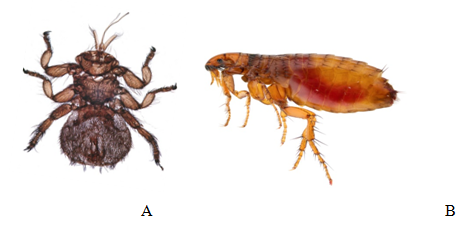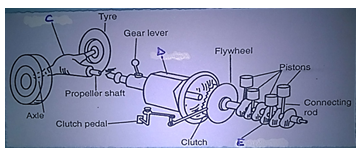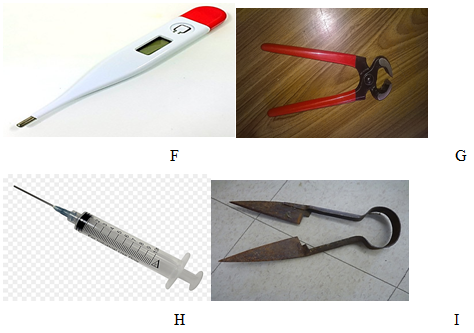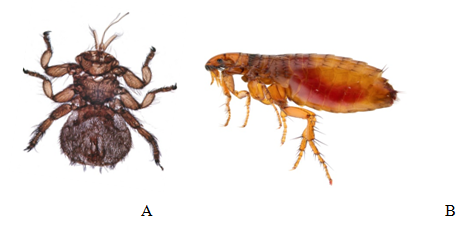INSTRUCTIONS TO CANDIDATES:
- Write your name and index number in the spaces provided above.
- Sign and write the date of examination in the spaces provided above.
- This paper consists of three sections A, B and
- Answer all the questions in section A and B.
- Answer anytwo questions in section
- All answers should be written in the spaces provided.
- This paper consists of 11 printed pages.
- Candidates should check the question paper to ascertain that all the pages are printed as indicated and that no questions are missing.
- Candidates should answer all the questions in English.
SECTION A (30MARKS)
- Give the meaning of the following terms as used in livestock health. (1mk)
- Incubation period
- Mortality rate.
- State four physical characteristics of a dairy cow. (2mks)
- Name the two different types of rabbit houses. (1mk)
- What is the role of a footbath in a poultry house?
- State four care and maintenance practices carried out on a tractor water cooling system.(2mks)
- State four factors that affect the digestibility of a feed. (2mks)
- Give four factors that should be considered when siting a beehive on the farm. (2mks)
- Name the complementary tool for each of the tools named below: (2mks)
- Trochar ……………………………………………………………………………………..
- Hand drill…………………………………………………………………………………...
- Elastrator……………………………………………………………………………………
- Bull ring…………………………………………………………………………………….
- State four advantages of embryo transplant when breeding livestock. (2mks)
- Give two reasons why sowsmay eat piglets immediately after farrowing. (1mk)
- State three reasons for docking in rams.
- Name four components of a building truss. (2mks)
- Differentiate between strategic and tactical treatment as used in the control of endoparasites.(1mk)
- Name four diseases in poultry that are controlled by vaccination. (2mks)
- List four vices that may be developed by birds kept under total confinement. (2mks)
- Give three reasons for steaming up an in-calf heifer.
- State four factors that influence the respiration rate in livestock. (2mks)
- Name three dual purpose breeds of sheep.
- Give two reasons why proper nutrition is important in livestock health. (1mk)
SECTION B (20MARKS)
- The diagrams below illustrate ectoparasites.Study them and answer the questions that follow.
- Identify the parasites labelled A and B. (1mk)
- Name the livestock affected by the parasite labelled A. (1mk)
- State two harmful effects of parasites A and B in livestock production. (2mks)
- Below is a diagram of the power transmission system of a tractor engine.Study itand answer the questions that follow.
- Name the parts labelled C, D and E. (3mks)
- State the functions of parts C, D and E. (3mks)
- Outline the procedure of castrating a male piglet. (4mks)
- At what age should the male piglet be castrated? (1mk)
- Study the tools below and answer the questions that follow.
- Identify the tools labelled F, G, H and I. (2mks)
- Give the usesofeach of the tools labelled H and I. (2mks)
- Name the part of the animal where tool F is placed when in use. (1mk)
SECTION C (40MARKS)
- Explain the management practices that a farmer should carry out to improve milk production in a low dairy herd. (10mks)
- Describe the rearing of one day old chicks to 8 weeks. (10mks)
- Describe coccidiosis disease under the following sub-headings
- Causal organism (1mk)
- Pre-disposing factors. (3mks)
- Symptoms. (4mks)
- Control measures. (2mks)
- Describe five parts of a piggery unit. (10mks)
-
- Give five functions of water in livestock. (5mks)
- State and explain five essentials of clean milk production. (10mks)
- Give five operational differences between a disc pough and a mouldboard plough. (5mks)

MARKING SCHEME
SECTION A (30 MARKS)
- Give the meaning of the following terms as used in livestock health. (1mk)
Incubation period
Duration between the time of infection and the time the first symptoms of the disease show up.
Mortality rate.
This is the likelihood of death occuring in a disease outbreak.It is expresed as a % of the affected animals and those which die.
- State four physical characteristics of a dairy cow. (2mks)
-Their bodies are wedge to triangular shaped.
-They have a straight top line.
-They have a well set apart hindquarter to allow room for the big udder.
-They have large and well developed udders with large teats that are well spaced.
-They have prominent milk veins.
-Their lean bodies carry little flesh.This is easily noted if the pinbone is visible.
-They have a large stomach capacity that enables the animal to feed heavily for high milk production.
- Name the two different types of rabbit houses. (1mk)
-The morant cage
-The hutch
- What is the role of a footbath in a poultry house?
Prevents the introduction of pathogens in the poultry house.
- State four care and maintenance practices carried out on a tractor water cooling system.(2mks)
-The water pump should be lubricated regularly.
-Clean water should be used in the radiator and trash removed from the fins.
-All pipes should be fitted tightly to avoid leakage.
-The radiator should be filled with clean water before starting the days work.
-The fan belt tension should be checked regularly and if it is too tight or too loose it should be adjusted accordingly.
- State four factors that affect the digestibility of a feed. (2mks)
-Chemical composition of the feed
-The form in which the food is offered to the animal
-The species of the animal
-The ratio of energy to protein
-The quantity of feed already present in the digestive system of an animal.
- Give four factors that should be considered when siting a bee hive on the farm. (2mks)
-Availability of water
-Availability of flowers
-A sheltered place ie from strong sun and wind.
-A place which is free from noise and other disturbances.
-Away from human beings and livestock.
-A place which is free from noise and other disturbances.
- Name the complementary tool for each of the tools named below: (2mks)
Trochar-Cannula
Hand drill-Bit
Elastrator-Rubber ring
Bull ring-Lead stick
- State four advantages of embryo transplant when breeding livestock. (2mks)
-It is possible to implant embryo from a high qualityfemale to less valuable female and hence improve the performance of the offspring.
-It stimulates milk production in a female that wasnot ready to produce milk.
-A highly productive female can be spread over a large area to benefit many farmers.
-It is easier to transport embryos in test tubes than the whole animal.
-Embryos can be stored for long periods awaiting availability of a recipient female.
- Give two reasons why sows may eat piglets immediately after farrowing. (1mk)
-Due to mineral deficiency.
-When they eat the placenta.
- State three reasons for docking in rams.
-To give a good fat distribution throughout the body.
-To prevent blowfly infestation as a result of the accumulation of dirt and feaces under it.
- Name four components of a building truss. (2mks)
-Cross tie
-Rafter
-Rafter batter
-Tie
-Strut
- Diffentiate between strategic and tactical treatment as used in the control of endoparasites. (1mk)
Strategic treatment is where the administration of the drugs is done regularly at the same time each year with the purpose of avoiding contamination and infection during the period of risk.
Tactical treatment is done in order to avoidoutbreaks when climatic or nutritional conditions are abnormal.
- Name four diseases in poultry that are controlled by vaccination. (2mks)
-Newcastle
-Fowl pox
-Fowl typhoid.
-Mareks disease
-Gumboro (Infectious bursa disease)
- List four vices that may be developed by birds kept under total confinement. (2mks)
-Egg eating
-Cannibalism
-Toe pecking
-Feather plucking
-Vent pecking
- Give three reasons for steaming up an in-calf heifer.
-It provides nutrients for maximum foetal growth.
-Helps build up energy for parturition.
-Ensures the birth of a healthy animal.
-Promotes good healthy of the mother.
-Increases and maintains a high milk yield after birth.
-Reduces the chances of milk fever in dairy cows.
- State four factors that influence the respiration rate in livestock. (2mks)
-Body size
-Amount of exercise done
-Degree of excitement.
-Environmental temperature.
- Name three dual purpose breeds of sheep.
-Romney marsh
-Corriedale
-Hampshire down.
- Give two reasons why proper nutrition is important in livestock health. (1mk)
-Prevents nutrient deficiency diseases.
-Ensures resistance against disease infection.
SECTION B (20MARKS)
- The diagrams below illustrate ectoparasites.Study them and answer the questions that follow.
- Identify the parasites labelle A and B. (1mk)
A-Ked
B-Flea - Name the livestock affected by the parasite labelled A. (1mk)
Sheep - State two harmful effects of parasites A and B in livestock production. (2mks)
-Cause irritation which lead to scratching.
-Causes wounds on the skin.
-Leads to anaemia.
- Below is a diagram of the power transmission system of a tractor engine.Study itand answer the questions that follow.
- Name the parts labelled C, D and E. (3mks)
C-Differential
D-Gearbox
E-Crankshaft - State the functions of parts C, D and E. (3mks)
C-It allows changes in the direction of the drive to right angles so that power is transmitted to the rear wheels.
-It enables the rear wheels to travel faster or slower than the other when negotiating a corner ie the tractor turns without the wheels skidding.
D-Provides different forward speeds ie allows the driver to select any forward or reverse gear.
-Allows change in speed ratio by altering the gears.
-Allows the driver to stop the tractor without suddenly stopping the engine or without keeping his foot pressed on the clutch.
E- It provides power to the belt pulley and the wheels.
-Transmits power from the connecting rod to the flywheel.
- a) Outline the procedure of castrating a male piglet. (4mks)
-Restrain the piglet.
-Disinfect the scrotum.
-Using a sterilised scapel cut the scrotum.
-Squeeze out the testes and gently pull out and cut the spermatic cord.
-Apply healing oil.
-Release the piglet.
b) At what age should the male piglet be castrated? (1mk)
2-3weeks of age.
- Study the tools below and answer the questions that follow.
- Identify the tools labelled F, G, H and I. (2mks)
F-Veterinary thermometer
G-Hoof cutter/trimmer
H-Hypodermic needle and syringe.
I-Wool shears - Give the uses of each of the tools labelled H and I. (2mks)
H-Injecting animals with drugs or vaccines.
-Extracting blood samples for laboratory analysis.
I- Shearing/clipping fleece/wool from sheep. - Name the part of the animal where tool F is placed when in use. (1mk)
-Rectum (acc anus) (rej vagina)
SECTION C (40MARKS)
- a) Explain the management practices that a farmer should carry out to improve milk production in a low yielding dairy herd. (10mks)
-Selection should be based on good health, high fertility and good body conformation.
-Poor animals should be culled.
-Selection and culling should be a continuous exercise.
-Use superior bulls/ semen from superior bulls to breed.
-Breed heifers when fully mature, considering weight.
-Breed cows 60 to 90 days after calving to maintain a calving interval of one calf per year.
-Keep the animals healthy by vaccinating them regularly
-Control external and internal parasites using appropriate drugs.
-Treat sick animals.
-Isolate sick animals which are suffering from contagious diseases.
-Prevent physical injuries by removing sharp objects near animal housing/ grazing areas and holes.Use plain fencing wire.
-Feed the cows on a balanced ration.
-Give adequate feed.The feed should be clean/ free from contamination.
-Provide minerals and vitamins to the cow.
-Provide proper housing with good ventillation.
-Avoid overcrowding in the animal houses.
-Milk cows at regular intervals.
-Handle the animals properly.
-Observe any signs of heat closely.
-Observe any signs of disease and parasite attack closely.
-Keep proper records.
-Evaluate the performance of the herd.
b) Describe the rearing of one day old chicks to 8 weeks. (10mks)
-Ensure brooder corners are roundedto avoid chicks crowding at the corners.This protects the chicks from being squeezed in the corners and suffocating to death.
-Provide enough brooding space of 10 birds per square metre.
-Clean and disinfect the brooder house and equipment.
-Provide proper litter in the floor/ wood shavings to a height of 5cm to 10cm to provide warmth and to absorb moisture from their feaces.Saw dust can only be used after the fourth week.
-Temperatures during the first week should be 30degrees then reduced accordingly by 2 degrees every week until 2 degrees in the 5th week.Supplementary heat is not required by the beginning of the 5th week.
-Maintain proper ventillation by adjusting the opening.
-Provide fresh adequate and quality feed.
-Provide adequate and appropriate waterers and feeders.
-Provide reliable and appropriate lighting.Dim light controls toe pecking.
-Control parasites using appropriate methods
-Chicks should be vaccinated at: 2 weeks against gumboro, 3-4 weeks against Newcastle,
7 weeks against fowl typhoid.
-Coccidiosis is controlled by giving coccidiostats through water and feed.
-Isolate and treat the sick chicks immediately.
-Debeaking should be done 8 to 10 days towards the end of brooding.
-Keep proper records.
- a) Describe coccidiosis disease under the following sub-headings:
Causal organism (1mk)
Coccidia of the Eimeria spp (It infects the lining of the alimentary canal)
Pre-disposing factors. (3mks)
-Wet, filthy and unhygienic animal sorroundings.
Overcrowding
Symptoms. (4mks)
Diarrhoea which may be whitish.
-Dysentery or blood in the dung.
-Birds have ruffled feathers, dull with drooping wings.
-Animals become emaciated
-Sudden death in birds, rabbits and kids.
Control measures. (2mks)
-Use of coccidiostats.
-Observing hygiene.
-Isolation in cattle.
-Overcrowding in a poultry house should be avoided.
b) Describe five parts of a piggery unit. (10mks)
-Feed store-This is a room for storing pig feed.
-Records room-This is used for keeping feed and weight records
-Pig pens-Pigs are kept in pens according to age and sex.These include: Farrowing pens, Gilts pen, Boars pen, In-pig pens and Weaners/fatteners pen.
-Running yard-These are extensions of the pens used for dunging and basking.
-Water troughs or drinking nipples-Used as watering points for the pigs.
- a) Give five functions of water in livestock. (5mks)
-It is a component of body cells and many body fluids such as blood.
-It is responsible for the transportation of nutrients from one part of the body to another.
-Makescells firm maintaining the shape of the body cells.
-Used in biochemical reactions in the body eg in the digestion of food.
-Helps to regulate body temperature through sweating and evaporation.
-Helps in the excretion of waste products from the body.
-It forms part of animal products eg milk which contains 83% and an egg which contains 55% water.
b) State and explain five essentials of clean milk production. (10mks)
-Healthy milking herd-Cows should be tested annually for milk-borne diseases eg tuberculosis and brucellosis which are easily transmitted to man.Affected animals are removed.A mastitis test should be done before each milking.
-Clean milking cows-The flanks, underline and the whole udder should be washed and dried thoroughly before each milking.Long hair on the udder should be clipped
-Healthy and clean milkman-The milkman should not be suffering from any contagious disease.Fingernails should be short and hair covered.Wear white overalls when milking and handling milk.
-Clean milking shed-Should be free from dust orodours.
-Clean milking utensils-Should be washed with hot water, rinsed and sterilised.
-Milk filtration, cooling and storage-Milk should be filtered and cooled immediately to 5 after milking.Cooling slows down bacteria multiplication.
-Avoid flavours in milk-Foodstuffs which cause bad flavours eg onions, Mexican marigold should be fed to cows after and not before or during milking.
c) Give five operational differences between a disc pough and a mouldboard plough. (5mks)
|
Disc plough |
Mouldboard plough |
|
Can be used on a field with obstacles eg stones, roots and stumps because of the rolling action of the disc. |
It is rigid and slides along in operation therefore it cannot be used on fields which have hard soil, stones, roots and stumps because it cannot ride over them. |
|
Does not invert the furrow slicescompletely.It leaves a rough field. |
Inverts the furrow slices completely leaving a clean field. |
|
More secondary operations are necessary after a disc plough is used. |
Fewer secondary operations are needed. |
|
Cuts at varrying depths because whenever it comes across obstacles it rides over them |
Operates on uniform depth because once the share is in the soil it follows the same depth. |
|
Not easily broken by obstacles because it rides over them. |
It is rigid and therefore can easily be broken byobstacles it comes across. |
|
Requires less power to pull when operating. |
Requires more tractor power to pull when operating. |
Download AGRICULTURE PAPER 2 - 2019 MOKASA II MOCK EXAMINATION.
Tap Here to Download for 50/-
Get on WhatsApp for 50/-
Why download?
- ✔ To read offline at any time.
- ✔ To Print at your convenience
- ✔ Share Easily with Friends / Students





